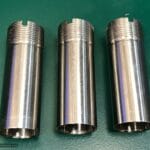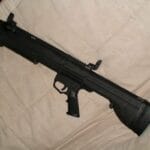Understanding how your shotgun’s pellets spread is crucial for hitting your target. That spread is controlled by the choke, a small but vital component at the muzzle end of your barrel. This guide dives deep into the world of shotgun chokes, from basic principles to advanced techniques, empowering you to choose the right choke for any shooting situation.
Decoding Shotgun Chokes: Constriction and Control
Think of a choke tube like a nozzle on a garden hose – it controls the spread of the shot pellets as they leave the barrel. The greater the constriction, the tighter the pattern. Matching the choke to your target and distance is paramount for consistent hits.
Choke Types: From Cylinder to Extra Full
Choke tubes come in a range of constrictions, each designed for a specific purpose:
Cylinder/True Cylinder (No Constriction): This choke provides the widest shot pattern. Imagine it like using no nozzle on that garden hose—maximum spread for extremely close targets. It’s best for targets under 25 yards, like close-flushing quail or skeet shooting.
Improved Cylinder (Slight Constriction): This choke offers a slightly tighter pattern than Cylinder, extending effective range to around 25-30 yards. It’s a solid choice for skeet, sporting clays, or close-flushing birds like rabbits or grouse.
Modified (Moderate Constriction): A versatile option offering a balance between spread and concentration. Effective out to about 30-40 yards, it’s a good all-around choke for many hunting situations, including dove, pheasant, and some waterfowl.
Full (Tight Constriction): This choke concentrates the shot for longer ranges, typically up to 40-50 yards. It’s well-suited for waterfowl hunting, trap shooting, and longer shots on upland birds. Full chokes reign supreme for the tightest shot patterns amongst general-purpose chokes.
Extra Full/Turkey (Maximum Constriction): Here’s your tightest pattern. These chokes deliver maximum downrange energy for dense patterns at 20-40 yards, ideal for turkey hunting or other situations demanding pinpoint accuracy. Beyond full choke, these specialized options offer even tighter patterns for specific hunting scenarios.
To illustrate choke performance, consider this table:
| Choke Type | Constriction (inches, 12 Gauge) | Approximate Pattern Percentage (30″ circle @ 40 yards) |
|---|---|---|
| Cylinder | 0.000 | 40-50% |
| Improved Cylinder | 0.010 | 50-60% |
| Modified | 0.020 | 60-70% |
| Full | 0.030-0.040 | 70-80% |
| Extra Full/Turkey | 0.045+ | 80%+ |
Remember, these percentages are estimates. Actual performance varies depending on ammunition and your specific shotgun.
Patterning Your Shotgun: A Crucial Step
Understanding choke theory is essential, but seeing how your specific shotgun performs is paramount. Patterning your shotgun is simple but invaluable:
Materials: Large paper targets (4’x4′ minimum), various shotgun shells, measuring tape, marker, and your shotgun with different chokes.
Setup: Securely place your target at a measured distance (typically 40 yards).
Firing: Load your chosen choke and ammunition, aim at the center, and fire a single shot.
Analysis: Draw a 30-inch circle around the densest part of the pattern. Count the pellet holes within the circle. A higher count indicates a tighter pattern. Repeat this process with different chokes and ammunition to find what works best for your shotgun.
Factors Affecting Pattern Tightness: Beyond the Choke
Choke constriction is the primary factor, but others also come into play:
- Ammunition: Shot size, type (e.g., lead vs. steel), and even wad design can alter pattern density. Some experts believe that even the brand of ammunition can influence pattern performance.
- Barrel Length: Longer barrels may contribute to slightly tighter patterns due to increased shot acceleration time, but this is generally a minor factor. Ongoing research suggests this effect is less pronounced than previously thought.
- Shotgun Action Type (Pump, Semi-Auto, etc.): While not a major factor, some studies suggest subtle variances in pattern performance between different action types. More research is needed to determine the full extent of this influence.
Choosing the Right Choke: Matching Tool to Task
A tight pattern isn’t always ideal. Over-choking can lead to missed shots, especially on closer, moving targets. Matching choke to target and distance is crucial. A full choke delivers the tightest general-purpose pattern, but other chokes are better suited for different scenarios.
Beyond the Basics: Advanced Considerations
- Choke Materials: Steel, stainless steel, and titanium each offer different durability, performance characteristics, and price points. Steel is common and affordable, while stainless steel resists rust. Titanium offers exceptional lightness but comes at a premium cost.
- Ported Chokes: These chokes may reduce recoil and muzzle jump, though the effectiveness varies.
- Pattern Analysis Software: For in-depth analysis, specialized software can precisely measure pattern density and distribution.
Delve into the fascinating details about www illinoistollway ves and uncover a wealth of information.
This guide provides a comprehensive understanding of shotgun chokes and shot patterns. Remember, the best choke isn’t always the tightest – it’s the one that matches your specific shooting needs. Continuous learning and experimentation are key to optimizing your shotgun’s performance.
















